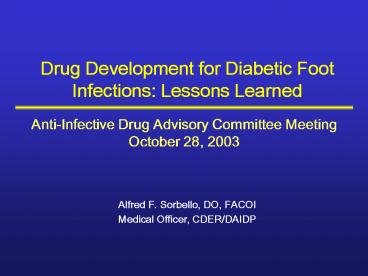Drug Development for Diabetic Foot Infections: Lessons Learned - PowerPoint PPT Presentation
1 / 18
Title:
Drug Development for Diabetic Foot Infections: Lessons Learned
Description:
hammer toes, valgus deformities. Soft tissue changes. chronic lower extremity edema ... Pulse oxygenation measurement (toe) Wound or ulcer dimensions. CRF ... – PowerPoint PPT presentation
Number of Views:85
Avg rating:3.0/5.0
Title: Drug Development for Diabetic Foot Infections: Lessons Learned
1
Drug Development for Diabetic Foot Infections
Lessons Learned
Anti-Infective Drug Advisory Committee
Meeting October 28, 2003
- Alfred F. Sorbello, DO, FACOI
- Medical Officer, CDER/DAIDP
2
Introduction
- Defining Diabetic Foot Infections
- Classifying Diabetic Foot Infections and Foot
Ulcers - Characterization of Study Population
- Adjunctive Treatment Measures
- Microbiologic Considerations
3
Definition of a Diabetic Foot Infection
- No generally-accepted definition
- Foot infections in diabetics can be ulcer- or
non-ulcer related - 15 of diabetics develop chronic non-healing
foot ulcers - Not all chronic foot ulcers are infected
- Clinical trials
- Broad studies of cSSSIs with supplemental studies
involving diabetic foot infections - Eligibility criteria
- Specific disease entities
- Discrete clinical findings
- Presence/absence of a foot ulcer
4
Common Lower Extremity Problems in Diabetics
- Developmental foot deformities
- hammer toes, valgus deformities
- Soft tissue changes
- chronic lower extremity edema
- dependent rubor
- stasis dermatitis
- chronic ulcers colonized with bacteria
- Decreased peripheral pulses
- Sensory peripheral neuropathy
- Charcot (neuropathic) joints
5
Comparative Prognostic Factors in Diabetics with
Osteomyelitis of the Foot
statistically significant
Bamberger et al. Am J Med 198783653-660
6
Clinical Trials Framework for a Definition for a
Diabetic Foot Infection
- Presence or absence of
- open wound, foot ulcer, break in skin
- clinical findings
- Anatomic location of primary site
- Depth of infection
- (skin/soft tissue vs. bone/joint)
- Isolation of pathogenic bacteria from an
appropriate culture specimen
7
Classification Systems for Diabetic Foot
Infections
- Classification systems
- Severity of Infection
- Foot Ulcer (Wound)
- No generally-accepted classification
- Differ in criteria complexity
- Require validation for clinical trials
8
Classification Systems for Severity of Diabetic
Foot Infections
- Limb-threatening vs. non-limb threatening
- Mild, moderate, severe
9
Classification Systems for Diabetic Foot Ulcers
- Wagner
- Univ of Texas
- S(AD) SAD
- Simple staging
10
Clinical Trials Framework to ClassifyDiabetic
Foot Infections
- Standardize definitions
- clinical disease entities
- assessments of ischemia, neuropathy
- Correlate with extent, natural history, and
prognosis of the infection - Distinguish skin/soft tissue from bone/joint
infections - Would need validation
11
Characterization of Study Population
- Demographics
- Co-morbidities
- Baseline Assessments
- Clinical Diagnoses
12
Demographics and Co-morbidities
- Age
- Gender
- Race
- Weight
- Country of Origin
- Study Center/Site
- Type 1 vs type 2 DM
- Peripheral neuropathy
- Peripheral vascular disease
- Renal insufficiency
- History of osteomyelitis
- History of lower extremity surgery
- podiatric, orthopedic, vascular
13
Baseline Assessments
- Laboratory
- hematology
- chemistry
- HgbA1C
- C-Reactive Protein
- Wound, tissue, and blood cultures
- Radiologic imaging
- Vascular evaluation
- Neurologic exam
- Pulse oxygenation measurement (toe)
- Wound or ulcer dimensions
14
Heterogeneity of Baseline Clinical Diagnoses CRF
Tabulation
FDA
CRF Tabulation
15
Adjunctive Treatment Measures
- Adjunctive treatments permitted per protocol to
augment wound healing - Are they utilized equally in all subjects in both
treatment groups? - Could adjunctive treatments make two dissimilar
drugs appear indistinguishable?
16
Adjunctive Treatments and Clinical Outcome
EOT end of therapy N number of subjects
- Trend indicative of improved cure rate associated
with increasing number of debridements.
17
Microbiologic Considerations
- Identify pathogens
- among polymicrobial infections
- Standardize culture methodology
- swabs, curettage, biopsy
- Microbiological outcome
- Presumed pathogen eradications predominate due to
healing of pre-therapy wounds/ulcers - outcome endpoints are clinically-driven
- follow-up cultures should be performed in
treatment failures
18
Guidance Development for DFIs
- Define and classify diabetic foot infections and
foot ulcers - Characterize study population
- Primary focus is on clinical outcome
- Standardize microbiologic methodology
- Effect of adjunctive treatment(s) on clinical
outcome - Separate clinical trials to assess drug
development for bone and joint infections































